Sweet grapes are a popular summer snack. But not only people like to nibble on the grapes, wasps and other animals also like to eat the delicious berries. Here you can find out how you can protect your grapes from wasps and the like.
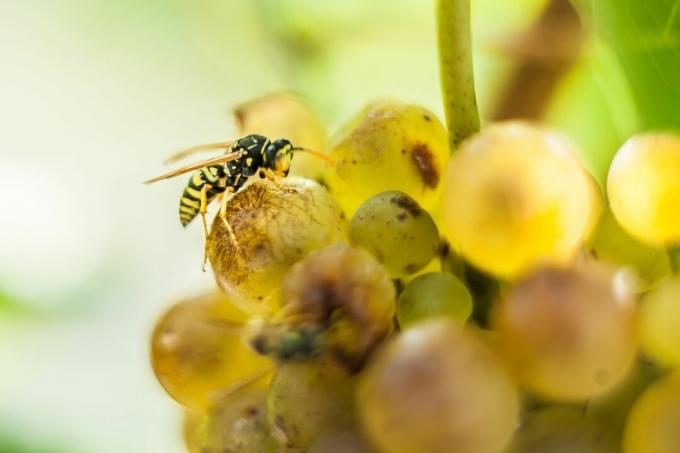
In autumn, many gardeners look forward to the sweet, delicious grapes (Vitis vinifera), which are now beginning to mature. It takes up to 120 days for the delicious grapes to develop their sweet taste and typical aroma. It is all the more disappointing when you have to notice that someone is already nibbling on the sweet grapes hat: Wasps also love the taste of grapes and like to eat large holes in them into it. Many bird species also see grapes as a welcome source of food. You can find out how to keep wasps away from grapes and what you should pay attention to when protecting grapes.
contents
- Why do wasps eat grapes?
- What damage do they do to grapes?
-
This is how you can keep wasps away from pigeons
- Protective grape pouch against wasp damage
- Water for the wasps
- Essential oils against wasps
- Primary rock flour to protect grapes
-
Protect grapes from birds
- Protective nets against birds
- Bird deterrent CDs
- Scarecrows
- Driving away birds with noise
- Supply other sources of food
Why do wasps eat grapes?
Many gardeners are amazed when they see wasps serving their grapes. It is a widespread prejudice that wasps feed mainly on animal food, for example other insects, or already damaged fruit. In fact, the menu of wasps is very diverse. Larvae mainly eat animal proteins, but adult wasps also feed on nectar, pollen and plant juices to a large extent. The following often applies: the sweeter, the better. For this reason, grapes are very popular with wasps - the sweet scent and high sugar content are very tempting to the wasps. Especially when fully ripe, when the grapes contain large amounts of sugar, they are an excellent source of food for wasps. During the ripening process, the thin skin of the grapes is no obstacle: the wasps can easily penetrate them with their mouthparts.
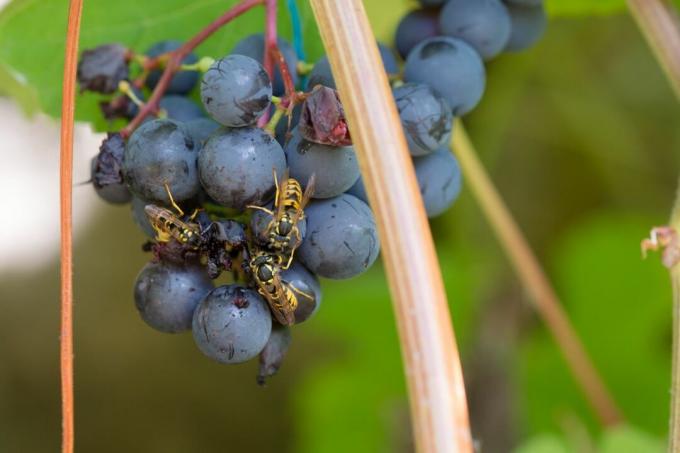
What damage do they do to grapes?
With their sharp mouthparts, the wasps eat holes in the individual fruits or can even hollow them out completely. In warm summers or when there are large numbers of wasps, this can have devastating consequences, as wasps can spoil a large part of the harvest. Not only are the damage caused by feeding a nuisance to gardeners - the injuries also make the grapes more susceptible to disease. Putrefactive fungi and acetic acid bacteria can consequently attack the grapes and severely damage them. In addition, grapes that are damaged or affected by fungi and bacteria are unsuitable for consumption. Unfortunately, even grapes that have not been eaten directly belong in the trash: Through The juice flowing down from higher-lying grapes can also quickly make them fall prey to fungal diseases will.
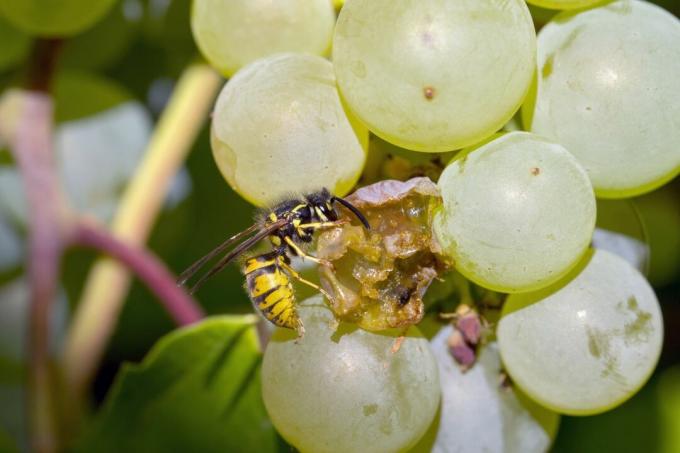
This is how you can keep wasps away from pigeons
Those who want a high-yielding grape harvest and are concerned that wasps could damage the grapes can take simple preventative measures to keep them away. Since wasps especially prefer grapes when they are fully ripe, it is sufficient to start protective measures a few weeks before harvest. But be careful: If the insects have already discovered the grapes as a source of food, it is often difficult to drive the wasps away on the grapes. If you want to protect your grapes from wasps, you should react as quickly as possible before feeding damage occurs.
Protective grape pouch against wasp damage
The best-known and safest way to protect grapes from insects is to use protective bags for grapes. Winegrowers have been using this type of grape protection for a long time, but hobby gardeners can also benefit from it. To protect the grapes, they are equipped with so-called grape protective bags a few weeks before the expected harvest time. These thin organza bags are placed individually over the grapes and then tied tightly. However, berries that are already damaged should be removed from the grape beforehand to prevent rot and disease from spreading to the healthy berries.

While bagging the grapes to protect them from wasps is a lot of work, this method does a big advantage: Since the wasps cannot eat through the organza tissue, the grapes are reliable protected. The airy fabric also allows the grapes to get enough air and sun so that they can grow undisturbed.
If you don't have organza bags on hand, you can also rely on paper bags. However, these should be checked regularly, as the paper is more susceptible to weathering. Plastic bags, on the other hand, are unsuitable for protecting the grapes - due to the lack of air exchange Condensation quickly builds up in them, which spoils the grapes and causes rotting favored.
Water for the wasps
One tip that is often suggested for repelling wasps is to distribute water. In fact, a fine spray mist, for example from a water bottle or a lawn sprinkler, causes the wasps to suspect rain and to withdraw. In practice, however, the protection of grapes with water has not proven itself: To keep the wasps safe to keep away, the sprinkler has to run the whole day, otherwise the wasps will search again immediately afterwards Grapes on. This not only results in enormous water consumption, but is also impractical in another respect - the combination of high Amount of water and an unfavorable soil ratio (for example due to a high clay content or compaction of the soil) can lead to waterlogging to lead. This can also damage the grapevine. In addition, the increased humidity caused by the water mist increases the risk of fungal diseases on the grapevine.
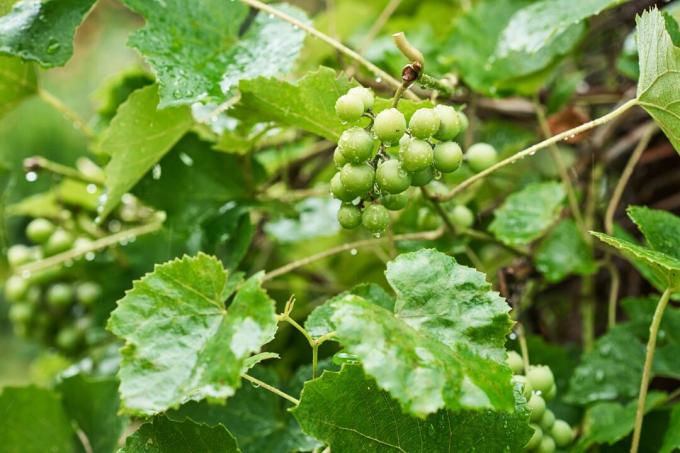
Essential oils against wasps
Essential oils are often cited as an insider tip when it comes to keeping wasps away. What works reliably on the terrace and balcony can only be used to a limited extent to protect grapes from wasps. Although wasps avoid the smell of certain oils (for example lavender) for this protection to be effective, it must, however, clearly mask the smell of the grapes.
In addition, the use in the garden turns out to be rather difficult: When spraying the vines with one Mixture of essential oils and water, care must be taken that the essential oils are correctly dosed are. Too low a dose of this has no effect, too high a dose of the essential oil can damage the grapevine. In addition, the treatment must be repeated regularly (especially when it rains) in order to maintain the smell. Scented candles or electric scented diffusers can distribute the essential oils over a large space, but are not suitable for unsupervised use in the garden.
Primary rock flour to protect grapes
If you want to drive wasps off your grapes, you might think about using insecticides. Instead of spraying them and thereby damaging valuable beneficial organisms, one can also use primary rock powder. Powdering the vines effectively drives wasps away. The easiest way to distribute the primary rock flour is to put it in an old stocking and shake it over the grapes. Alternatively, you can mix the rock flour with water and spray it on the grapes.
The layer of stone meal on the grape drives away wasps in several ways: On the one hand, they avoid the unpleasant, gravel-like one On the other hand, the taste of the rock meal covers the sweetness of the grapes and makes it suitable for the wasps less attractive.
Depending on the weather (especially in heavy rain or wind) it may be necessary to pollinate the grapes several times. However, one should be careful not to cover too many leaves with the primary rock powder: If there is too much flour on the leaves, this can influence photosynthesis. When the harvest time has come, the grapes should be washed thoroughly once to remove the primary rock flour. Then you can enjoy them without hesitation.
Protect grapes from birds
Not only wasps eat grapes - birds also like the sweet berries. Above all Starlings and Blackbirds show great talent in stealing the juicy grapes directly from the vine. But other bird species also like to use the grapevine as a source of food. Once the birds have discovered the vines, they often fly so often that there is hardly anything left for the gardener. Fortunately, there are a few methods that can be used to protect grapes from birds.

Protective nets against birds
The classic way to protect grapes from birds is the so-called bird protection net. Due to the close-meshed nets, birds can no longer get to the grapes and are thus effectively prevented from stealing grapes. However, there are a few things to consider with bird protection nets: The green, fine-meshed nets that are offered in many garden centers often turn out to be death traps. Because the animals do not see them well and can get tangled up in them. Instead, conspicuous nets, for example in blue, are much more suitable, as they can also be easily recognized by birds.
Gardeners often choose large-meshed nets in the belief that they are particularly bird-friendly. Unfortunately, this is a misconception: Small bird species can get parts of their bodies caught in the large meshes and thus get tangled or injured. When buying a protective net, you should therefore ensure that the mesh size is a maximum of 25 x 25 mm.

When attaching it, make sure that the net closes tightly against the vines at all points and that there are no gaps through which birds can get lost under the net. If the bird protection net forms such a gap, the net can be fixed to the grapevine at this point with clothespins. In addition, the net should not lie on the ground, because hedgehogs, toads or lizards can also get caught in it.
In fact, with grapevines, it is often not necessary to use the entire vine. If the grapes are hanging at about the same height, it is sufficient if the grape zone is only wetted on the side. However, here, too, it is important to ensure that there are no gaps in the fastening so that no bird gets lost inside the safety nets. Daily checks are compulsory, even if a bird protection net is meticulously attached: it gets caught unfortunately an animal in this one, so hopefully you can still help him and get it out of his predicament to free.
Bird deterrent CDs
If you are looking for a gentle way to protect your grapes from birds, you can build an effective bird fright with a little manual skill. The materials for this can be found in almost every household: old CDs and a little string. The CDs can be attached individually or in rows on or in the immediate vicinity of the grapes so that they can move freely in the wind. The birds are startled by the movement and the reflection of the sun on the reflective side of the CDs and prefer to stay away from this place in the future.
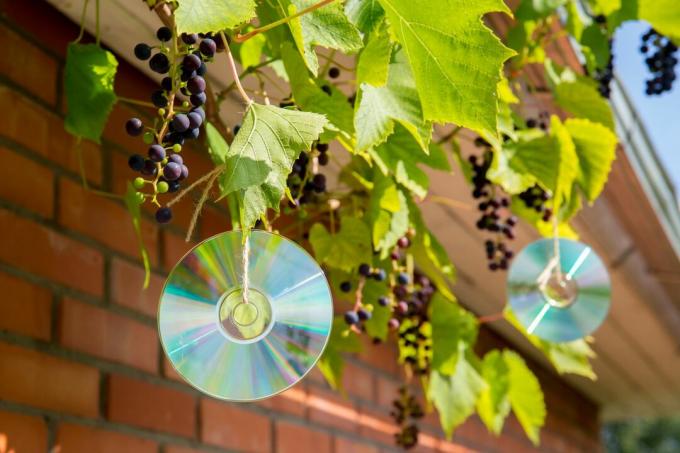
However, care should be taken to attach the CDs early - once the birds have discovered the fresh grapes, their appetite often defeats them Afraid of the flashing CDs. Even bad weather with cloudy skies can reduce the effectiveness of the CDs, as the reflections from the mirror surfaces fail. In addition, it quickly leads to a habituation effect, so that after a while, smarter bird species can no longer be driven away by it. As a temporary solution to keep the birds away from the grapes for a short time, the CDs are considered to be quite effective.
Scarecrows
A scarecrow in the garden can not only serve as a decorative eye-catcher, but also be very helpful in protecting grapes from birds. However, a few tricks should be observed so that the scarecrow can also develop its full effect: The scarecrow should look as human as possible. This is not only for decorative reasons, but also scares off birds, which recognize a human body in the silhouette of the scarecrow. Movable parts and loose clothing that flutters in the wind give the scarecrow more liveliness and thus better drive away the birds. Reflective clothing and noises, for example from rattling tin cans on the bird barn, also increase effectiveness.
In order to minimize any habituation effect, the scarecrow should regularly change clothes (and if possible also the location). Especially the cunning corvids like Magpies and crows otherwise quickly recognize that the scarecrow is a dummy.

Driving away birds with noise
Nobody finds noise pleasant - this also applies to birds. If you want to protect your grapes against birds, noise is an effective and at the same time harmless method. Wind chimes, bells or rattling tin cans often cause too much noise for the animals and drive them away. The birds are also reliably driven away by music or other loud sounds.
Unfortunately, the noise has two disadvantages: On the one hand, not only the birds, but also the people in the immediate vicinity often feel disturbed by the noise. On the other hand, if the garden is constantly exposed to sound, it can lead to a habituation effect, so that the birds suddenly reappear despite the noise. You should therefore vary the duration, type and timing of the noises over and over again.
The use of ultrasound devices is therefore more pleasant. These generate sounds that humans do not perceive, but are perceived as unpleasant by birds. Devices that have a motion detector also minimize the habituation effect, as they do not continuously emit noises.

Supply other sources of food
When birds are hungry, they also attack our beds. A bird-friendly method of protecting grapes from birds is therefore to offer them other food sources. A bird feeder that is as far away as possible from your grapes attracts the birds to another area of the garden.
It is now important to choose the right bird feed: Grains and seeds, as we know them from classic bird feed, are rather unsuitable for distraction. In fact, it is soft feed eaters such as blackbirds and starlings that particularly like to feed on grapes. Their menu mainly includes insects and berries, but also fruit. If you offer them leftover fruit, collected grubs, worms or even a few old grapes, the birds can quickly be persuaded to take their food from the bird feeder instead. It is essential to continue feeding until the harvest is complete - this is the only way to prevent the birds from rushing to the vines again if they are not fed.
Would you like to learn more about how to properly feed birds? Our special article doesn't just tell you how to Make birdseed yourself, but also everything you need to know about the different types of feed and the choice of the right feed.
